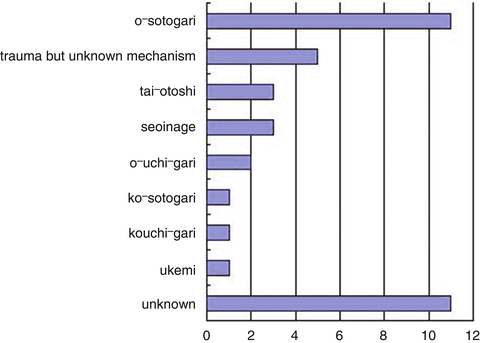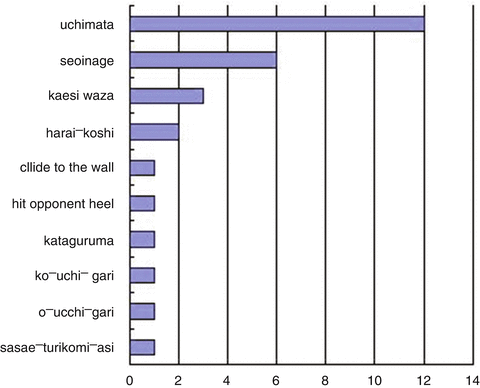Fig. 6.1
Frequency of concussions
In terms of the time when the first concussion occurred, 114/1,114 (10.2 %) athletes were in elementary school, 265/1,400 (18.9 %) were in junior high school, 194/1,084 (17.9 %) were in senior high school, 80/6,410 (12.4 %) were in college, and 2/24 (8.3 %) were in amateur sports (Fig. 6.2). Examination of these data indicates that sustaining a concussion is more frequent in junior and senior high school.


Fig. 6.2
When did the concussion was occur?
With regard to the cause of concussion, in 645 cases the injury occurred when the Judo athlete’s partner executed a Judo technique. The most frequently reported Judo technique was the osotogari (sweeping leg throw) (37.1 %). However, 14.3 % of the athletes reported that they did not remember which Judo technique was executed prior to their concussion. The seoinage (shoulder throw) was also a common Judo technique that caused concussion in 12.4 % of the athletes. Overall, in Judo practice, a concussion occurred more frequently in cases where an athlete was thrown to the mat by the back than when thrown to the mat by the front.
6.2.2 Severe Traumatic Head Injuries
Severe traumatic head injuries (including death or severe sequelae) were investigated using records from insurance claims from a system for disability benefits and consolatory money maintained by the All Japan Judo Federation (2003–2012). Thirty-nine cases of severe traumatic head injuries (35 male and 4 female) were reported. Thirty-five cases were diagnosed as acute subdural hematoma, and 21 of those resulted in death. Many of the injuries occurred during the first year of junior and senior high school, and most of the injured students were beginners (Fig. 6.3). Based on these 39 cases, the severe traumatic head injuries were caused when an osotogari or seoinage throw was executed. These throws were previously noted as mechanisms of concussion in the study above, which indicates that severe traumatic head injuries and concussions have similar causes.


Fig. 6.3
Techniques that lead to severe brain injuries
6.2.3 Severe Traumatic Neck Injuries
Severe traumatic neck injuries (including fracture, dislocation, and cervical cord injury) were caused by a fall in which the athlete’s forehead hit the mat. Twenty-nine cases of these injuries were reported, and many of the neck injuries were caused by an uchimata (inner thigh throw) or haraigoshi (sweeping hip-to-loin throw), either of which could also cause a concussion. Thus, a direct impact to the forehead can also be one of the risk factors for a concussion (Fig. 6.4).


Fig. 6.4
Techniques that lead to severe neck injuries
Any direct or indirect impact to the head that might result in a concussion can cause severe injury. In Judo practice, some form of impact is applied to the head regardless of whether an athlete is thrown to the mat by the front or the back. In summary, if the situations that cause a concussion can be avoided, then severe traumatic neck injuries can also be prevented.
6.2.4 Judo-Related Injuries During Regular Class and After School Activities
Is the Judo technique itself related to falls in which the athletes’ heads or necks hit the mat? According to data reported by the Japan Sport Council, with regard to the number and rate of sports-related injuries by anatomical location of Judo activity, head trauma accounted for 9.8 % of the total injuries (2007–2009). Moreover, in terms of the rate of injury, there was no difference between Judo practiced in a regular class setting or in after school activity clubs. This data suggests that beginners in a regular class are also prone to head trauma (Table 6.1).
Table 6.1
Investigation of athletic injuries in Judo
Parts | Regular class | After school activity | ||||
|---|---|---|---|---|---|---|
Cases | % | Incidence per 100,000 | Cases | % | Incidence per 100,000 | |
Head | 2,189 | 9.8 | 10.52 | 1,366 | 3.7 | 640 |
Forehead | 38 | 0.2 | 0.18 | 107 | 0.3 | 50 |
Eye | 479 | 2.1 | 2.3 | 701 | 1.9 | 328 |
Ear | 43 | 0.2 | 0.21 | 293 | 0.8 | 137 |
Nose | 267 | 1.2 | 1.28 | 240 | 0.7 | 112 |
Mouse | 41 | 0.2 | 0.2 | 98 | 0.3 | 46 |
Tooth | 187 | 0.8 | 0.9 | 376 | 1 | 176 |
Cheek | 24 | 0.1 | 0.12 | 44 | 0.1 | 21 |
Jaw | 35 | 0.2 | 0.17 | 57 | 0.2 | 27 |
Neck | 1,656 | 7.4 | 7.96 | 1,108 | 3 | 519 |
Shoulder | 2,222 | 10 | 10.68 | 5,590 | 15.3 | 2,618 |
Upper arm | 251 | 1.1 | 1.21 | 675 | 1.8 | 316 |
Elbow | 898 | 4 | 4.32 | 2,816 | 7.7
Stay updated, free articles. Join our Telegram channel
Full access? Get Clinical Tree
 Get Clinical Tree app for offline access
Get Clinical Tree app for offline access

| |





